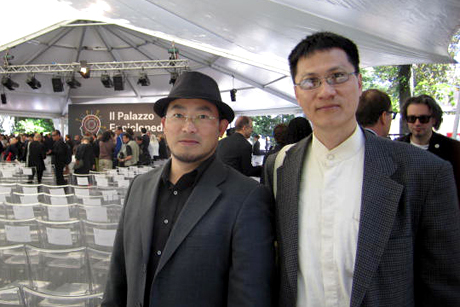Venice exhibit aims to keep island afloat
By Kathy Hovis

The Polynesian island nation of Tuvalu will someday be swallowed by the ocean as the first victim of a rising ocean level caused by global warming. It’s easy for most people to ignore this fact since it is such a faraway place – but not for An-yi Pan, associate professor of the history of art. Pan is curating an exhibit focused on Tuvalu this summer at the Venice Biennale, a major contemporary art exhibition in Italy, and he also feels strongly about raising awareness of climate change.
The Tuvalu Pavilion at the biennale features Taiwanese artist Vincent J.F. Huang, whom Pan met while traveling to find artists for an upcoming exhibit on Contemporary Taiwanese art that he’s curating at Cornell’s Herbert F. Johnson Museum of Art. Much of Huang’s work focuses on promoting awareness about and preventing global warming.
“Activism is something that is very fashionable among contemporary artists,” Pan said, although artists throughout history have used their work to express their concerns about social and environmental problems. Pan’s research interests lie with Buddhist art as well as modern Chinese and contemporary Taiwanese art. “Even during the Tang Dynasty, artists used their work to explore ways to find harmony between the self and the environment,” he said.
The Tuvalu exhibit includes a gold-plated Wall Street bull hung by its tail and an oil pump that transforms into a machine-killing natural species. A live coral reef aquarium with miniature sculptures of iconic landmarks like the Statue of Liberty is submerged in the tank.
“The highly industrialized nations seldom take responsibility for global environmental and climate crises, because any steps taken would jeopardize their own national interests – weaker economic growth indicators, rising unemployment rates, and rising prices, resulting in higher inflation,” Pan writes in the exhibit notes. “In this unnatural trend we incessantly look for excuses to continue our ‘progress,’ but in reality, we are destroying our only space for survival.”
The job of curator involves months of work – from sending out proposals to negotiating terms and finding sponsors. Curators also think about the theme for the exhibit, select the works, design the display and write notes for websites and exhibit catalogs.
The week before opening, Pan, Huang and others were on hand for the set-up. “We had to have an oil rig shipped to Venice,” Pan said of some of the trickier parts of the job. “And the week before we arrived, Venice was underwater because of some recent flooding. We know that our exhibit is important to Venice as well as places like Tuvalu.”
Curating exhibits inspires Pan in the classroom as well. “Projects like those show students the possibilities of what they can work on,” he said.
The Tuvalu Pavilion will be on display in Venice through Nov. 24, and Huang and Pan are working to find other museums to which the exhibit might travel. They also hope the biennale sparks interest from celebrities who might advocate for more action to be taken to help Tuvalu and other threatened places.
Learn more about the exhibit at tuvalupavilion.com.
Kathy Hovis is a writer for the College of Arts and Sciences.
Media Contact
Get Cornell news delivered right to your inbox.
Subscribe